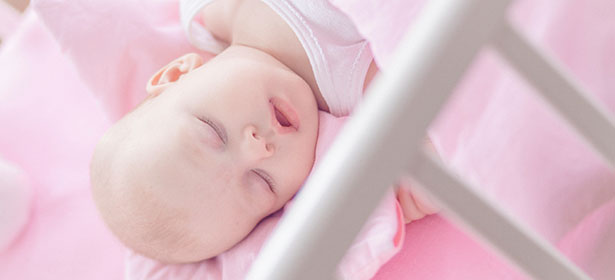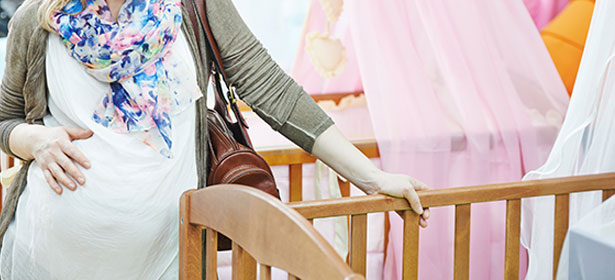

A cot bed needs to look good in your child's nursery, but you also want one that's going to keep your baby safe while sleeping, and be easy for you to put together and use. After quizzing over 1,500 parents on cot beds, we can reveal which brands score top marks for customer satisfaction.
There's a good chance you're familiar with lots of the names included in our latest survey – Ikea, John Lewis and Mamas & Papas all make an appearance. But we've also uncovered a selection of lesser-known brands that parents have placed their trust in.
Keep scrolling to discover the best and worst cot bed brands, as voted for by parents. You'll also spot our expert advice on which type of cot bed is right for your child, standard sizes, safety consideration, plus the cot bed features worth looking out for.
Ways to keep your family living costs down, and kids of all ages happy Get our Family newsletter – it's free monthly

A good cot bed can last from six months up to six years, by which time your child will be ready to move to a single bed. By checking in with the results of our cot bed survey, you can make sure you're buying from a brand that's impressed parents across the UK.
Our results table below summarises the results of our cot bed survey. Each brand is ranked by customer score, which highlights whether or not customers would recommend the brand. At the time of writing, we don't test or review individual cots or cot beds.
Only logged-in Which? members can view our recommendations in the table below. If you're not yet a member, join Which? to get instant access.
Readers that are not logged in will see cot bed brands listed alphabetically.
Our top cot bed brand boasts an impressive customer score of 81%. Over 250 parents said they had used or owned a cot bed from the brand, which sells pushchairs, car seats, feeding essentials and travel accessories.
Once you choose your cot bed, you'll need to pick the perfect cot mattress to pair with it. See all our cot mattress reviews to find out which ones our experts recommend.

As part of our latest cot bed survey, we quizzed parents on which cot beds they were using at home.
We've crunched the numbers and there's a clear winner. A hefty 25% of respondents told us they used a cot bed from the most popular brand.
Only logged-in Which? members can view the brands below. If you're not yet a member, join Which? to get instant access.
As you can see, two cot bed brands race ahead of the pack in our survey comparing ownership rate.
Prices for the top brand's cot beds start at around £250 and rise beyond £600. One of its cheaper options has a light oak finish and comes with three cot base heights, suitable for children up to 'approximately four years'.
Not far behind our most popular brand was a rival that sells cots that have drawers included. Partner up with this brand and you can expect to spend anywhere between £65 and £350. In other words, it's worth considering if you're on a tight budget.
Once your baby grows out of a Moses basket or bassinet, which most parents use for a newborn, he or she will need to move into a cot or cot bed. There are pros and cons associated with each of them.

A cot bed is a cot with removable sides and a removable end panel that can be converted into a toddler-sized bed.
Most cot beds will last until a child is seven or eight years old. But this will depend on their weight, and how much wear and tear they put the bed through.
Cot beds are generally around 70cm wide – so they give your baby a bit more space to roll about and stretch their arms. They’re not necessarily that much more expensive, though.
If you have the space, it might make sense to buy a cot bed from the outset, as it will last longer and you can avoid the hassle of having to buy two separate pieces of furniture.

Cots are generally smaller than cot beds – around 50-60cm wide – so if your baby’s bed will be in your room until he or she is six months old, as is the current advice, a cot may fit more easily if space is limited.
Sizes do vary, though. Cots designed to fit 'standard-sized' cot mattresses are a few centimeters narrower than cots designed for 'continental-sized' mattresses, although they're often a similar length (around 140cm). Measurements should be clearly displayed on the cot label.
You can buy bedside cots with a removable side, so you can position it right next to your bed. You can adjust the base so your baby’s mattress lines up with yours, which makes night-time feeding easier.
Take a look at our bedside crib reviews to compare all of the bedside cribs we've tested or go straight to the best bedside cribs to see ones we rate.
As a general rule, a cot is suitable from birth up until around two years old. These products are designed for young infants.
A cot bed can be converted from an infant cot to one that's suitable for toddlers. In other words, a cot bed is suitable from birth up until around four years old. At which point, you can then convert most cot beds into a junior bed.
For expert advice on how to assemble a cot bed, where to position it and when to switch to a junior bed, see our guide on using cot beds safely .
A standard cot or cot bed – rectangle shape, fixed sides – isn't your only option. You could choose to go for a drop-sided, sleigh, or one with a drawer or storage built in.

Some cot beds and cots have one side rail that can drop down to give better access for getting your baby in and out.
There are different ways to lower the drop side. Some drop-sided cots and cot beds have a nudge-and-lift mechanism, which is helpful because you can operate it with one hand while you've got your baby in the other. Others have catches, a trigger mechanism or a foot pedal.
The drop side and the back rail are usually removed when you convert a drop-sided cot bed into a junior bed.

Sleigh cot beds are popular with parents. The name comes from their wavy design, which makes them stand out from their straight-sided counterparts.
When you're buying, check that the sleigh-shaped ends, which are usually bolted on either side of the head and foot boards, don't create a dip or groove between the pieces of wood where your baby's clothing could get caught.
Sleigh cot beds can be either drop-sided or have fixed sides. The side rails will be removed to turn the cot into a bed.

Some cots and cot beds use what's essentially dead space beneath the base and the legs by including a drawer.
A cot bed with a drawer might be ideal for you if your baby's nursery is small and lacks storage space.
It's possible to get sleigh cot beds and cots with drawers.

Cots are generally around 120cm long x 60cm wide, while cot beds are typically bigger, averaging at 140cm long x 70cm wide. However, cot beds do come in different designs, so sizes can vary.
Most cot beds also have side rails that are around 84-87cm high in the highest position, which makes them challenging for shorter people to reach over. A cot bed with a drop-side will reduce this height, making it easier to reach your baby when the base is on the lowest position.
Double check the cot bed you choose will fit in your bedroom (where your baby is meant to sleep for the first six months), as well as where you plan to put it in the nursery. If space is limited, you may decide to go for a cot rather than a cot bed.
When shopping for a cot mattress, you need to buy one with the same dimensions as your cot bed or cot so that the mattress fits snugly into the frame.
Consult our guide on the best cot mattresses to see which options ace our expert tests.

Cot beds are generally more expensive than cots. However, as they'll be in use for longer than a cot, they can be the more cost-effective option.
Prices for cot beds vary depending on style and the materials used, but you should expect to spend anywhere between £200-700.
Cots can start from as little as £60, but most land within £100-300.

Consider investing in a baby monitor so you can watch over your little one's cot. Our expert guide uncovers the best baby monitors .
There are plenty of retailers on the high street that sell cots, with the list including Dunelm, Ikea and John Lewis. Shopping in-store means you can take a look at the cots up-close and get a sense of how much room they'll take up.
Whether you're shopping in person or online, make sure you're dealing with a reputable retailer and note the returns policy.
Popular online retailers that sell cot beds and cots include:
To see which baby and child shops are rated highly, consult our expert guide on the best and worst baby and child shops .

Using a second-hand cot could save you some cash, but there are some essential safety tips to read first.
For one, you need to buy a new mattress for the cot – there should not, at any point, be a gap of more than 3cm between the mattress edge and the cot. Don't choose a mattress with handles, as these may trap your baby's hands or feet.
You also need to make sure the product conforms to British Safety Standards BS EN 716 as a cot, and BS 8509 as a bed. Have a look in the instructions for a BS number, or check for markings on the cot itself.
The bars should be no more than 6.5cm apart, so your baby can't get stuck between them. Check that there's at least 50cm between the top of the mattress and top of the cot.
Make sure the drop-side mechanism works smoothly, and stays reliably in the ‘up’ position. You should also ensure the drop side can't be lowered by a child.
If you're going second-hand, get a copy of the original instructions.
For more expert advice that can help you kit out your home with the right equipment, see our nursery and feeding page.